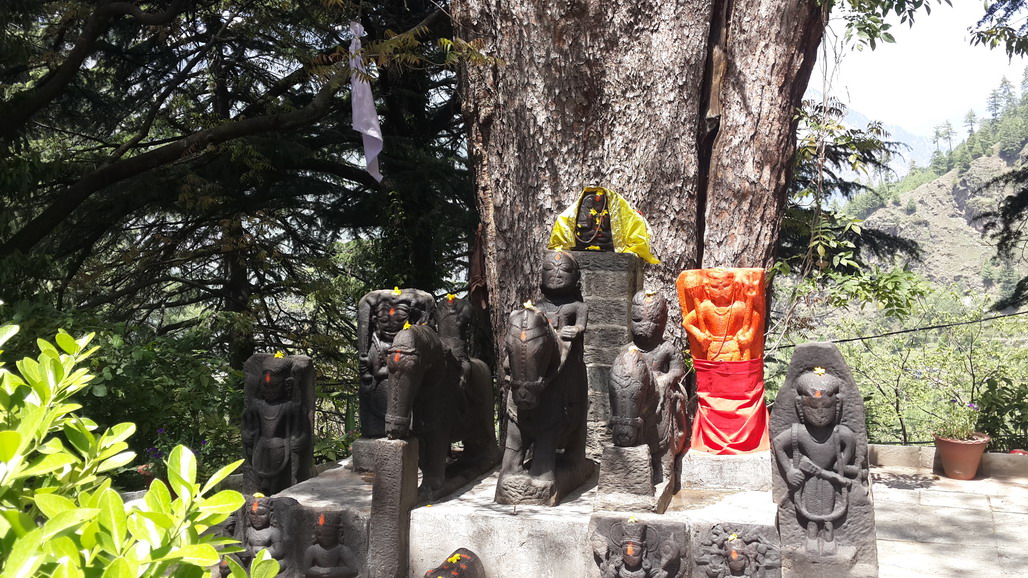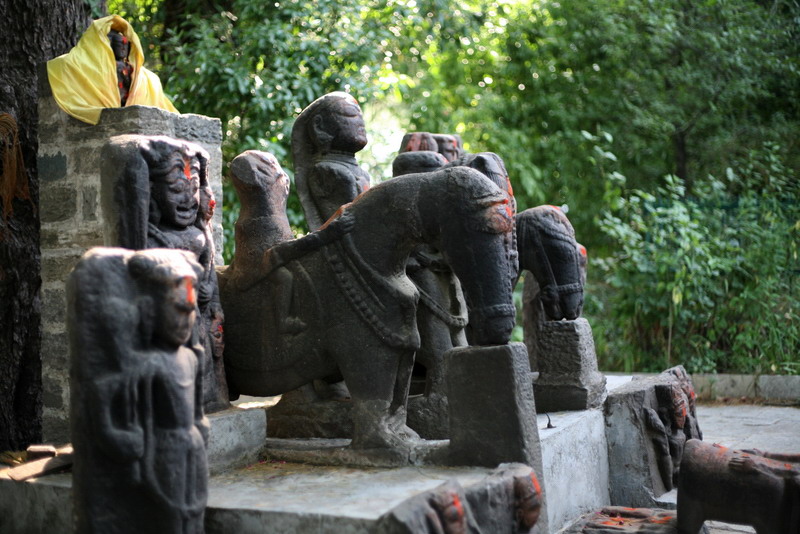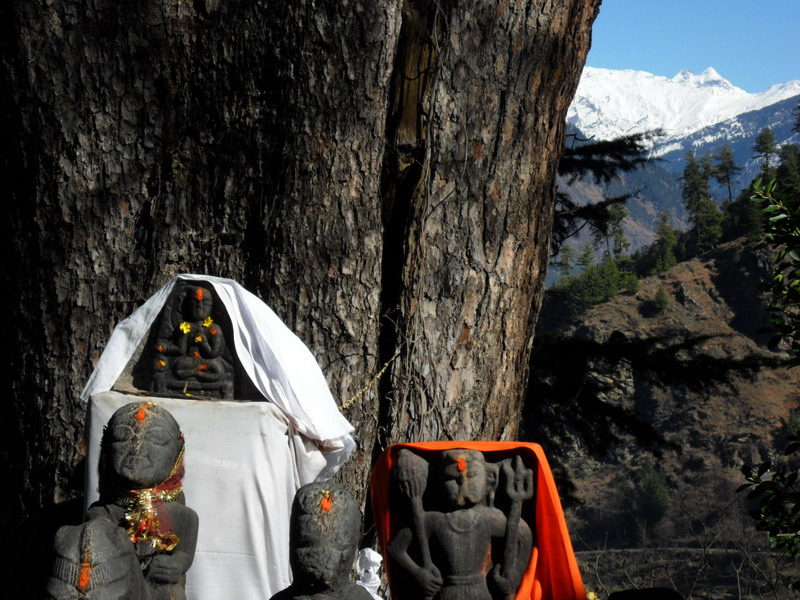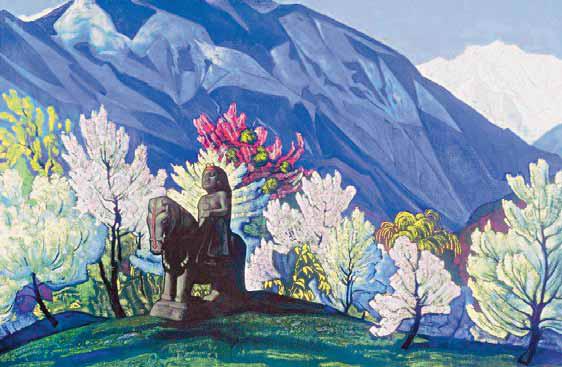Gods and Guardians of the Kullu Valley
 The collection of stone images of gods, rishis (sages) and heroes, the guardians of the Kullu valley arranged under the age-old Himalayan pine next to the Roerich House is an open temple-exhibition of sorts. In the time of the Roerichs till the beginning of 1990s only the equestrian statue of Guga Chauhan and a small image of Narsingh attached to the tree trunk were kept here. In 1990s during the construction of the garage for the memorial car of the Roerichs all stone images to the west and north of the House were shifted to the pine. That is how the open temple of Guga Chauhan sometimes called the temple of Narsingh came into being. Every morning the local priest conducts puja here and the IRMT staff come here to pay obeisance before doing their daily chores.
The collection of stone images of gods, rishis (sages) and heroes, the guardians of the Kullu valley arranged under the age-old Himalayan pine next to the Roerich House is an open temple-exhibition of sorts. In the time of the Roerichs till the beginning of 1990s only the equestrian statue of Guga Chauhan and a small image of Narsingh attached to the tree trunk were kept here. In 1990s during the construction of the garage for the memorial car of the Roerichs all stone images to the west and north of the House were shifted to the pine. That is how the open temple of Guga Chauhan sometimes called the temple of Narsingh came into being. Every morning the local priest conducts puja here and the IRMT staff come here to pay obeisance before doing their daily chores.
 Gods play an important role in the life of the Kullu valley. In his essay Gods of Kuluta (1929) Nicholas Roerich writes, “In this ancient place they have their three hundred sixty gods. Among them also is Gotama Rishi dedicated to Buddhism, which is known to have been here for ages. There is also Akbar the Great, whose statue is in the Malana temple, and all teachers and heroes who by sword or spirit won great battles.”
Gods play an important role in the life of the Kullu valley. In his essay Gods of Kuluta (1929) Nicholas Roerich writes, “In this ancient place they have their three hundred sixty gods. Among them also is Gotama Rishi dedicated to Buddhism, which is known to have been here for ages. There is also Akbar the Great, whose statue is in the Malana temple, and all teachers and heroes who by sword or spirit won great battles.”
Roaming in the field one day Nicholas Roerich noticed an unusual-looking rock sticking out of the ground. It was a stone foot wearing a boot. When it was unearthed it turned out to be an equestrian figure. “It’s Guga Chauhan, the guardian of the valley,” said the locals. The image was installed in the courtyard under the pine. Above it on the tree trunk the stone image of Narsingh was fixed. Every day priests came to conduct puja in honour of the ancient heroes.
History preserved the account that Guga Chauhan was a Rajput prince who set up in the 10th century A.D. a state in the northern part of Rajasthan adjacent to Punjab and Haryana. He is remembered as a just ruler, courageous fighter and also a great yogi. He was initiated into a natha yogic tradition, which traces its origin to the renowned yogi Gorakhnath. According to the legends Guga was his disciple and performed multiple miracles. It is believed that part of their life passed in the Kullu Valley. Nicholas Roerich depicted the statue of Guga Chauhan in several of his paintings including Guga Chohan. Kuluta (1931) and Kuluta (1936).
 In his struggle against foreign invaders Guga Chauhan was supported by his right hand and comrade in arms Narsingh and his sister Gugi. In the temples of Guga Chauhan their equestrian images are always placed together: Guga Chauhan, his sister Gugi Chauhan and Narsingh. Nowadays the locals say that the central image, which was discovered by Nicholas Roerich, depicts valiant Gugi, the sister of Guga Chauhan. The image to the right of her is legendary Narsingh, while the image to the left is Guga Chauhan himself. As legend has it, Guga had his head cut off in a hard battle but continued fighting for a another three days. These heroes have become the guardians of the Kullu valley. They protect Naggar, the Roerich Estate and “Urusvati” Institute.
In his struggle against foreign invaders Guga Chauhan was supported by his right hand and comrade in arms Narsingh and his sister Gugi. In the temples of Guga Chauhan their equestrian images are always placed together: Guga Chauhan, his sister Gugi Chauhan and Narsingh. Nowadays the locals say that the central image, which was discovered by Nicholas Roerich, depicts valiant Gugi, the sister of Guga Chauhan. The image to the right of her is legendary Narsingh, while the image to the left is Guga Chauhan himself. As legend has it, Guga had his head cut off in a hard battle but continued fighting for a another three days. These heroes have become the guardians of the Kullu valley. They protect Naggar, the Roerich Estate and “Urusvati” Institute.
 The gods of the Kullu valley dispense justice, travel around the valley and communicate with their worshippers through their gurs or shamans. Nicholas Roerich quotes one of the local gurs: “The Gods in the valley live in prosperity. They have plenty of property and land. Without their sanction nobody is allowed to fell a tree. The gods visit each other as guests. Many people have seen the gods travelling. Sometimes they fly, sometimes they walk with great leaps propping themselves on sticks. Of course, besides that they several times every year they have triumphal processions with drumbeats and trumpets...”
The gods of the Kullu valley dispense justice, travel around the valley and communicate with their worshippers through their gurs or shamans. Nicholas Roerich quotes one of the local gurs: “The Gods in the valley live in prosperity. They have plenty of property and land. Without their sanction nobody is allowed to fell a tree. The gods visit each other as guests. Many people have seen the gods travelling. Sometimes they fly, sometimes they walk with great leaps propping themselves on sticks. Of course, besides that they several times every year they have triumphal processions with drumbeats and trumpets...”
Gurs of the gods are most revered in the Kullu valley. “The gur is seated on a rug,” narrates Nicholas Roerich, “and having completed the burning of his incense, he gives every one of us a flower as a sign of the grace of the gods. The gods are very satisfied, he informs us. We did not offend them. On the contrary, we have even collected their images near our house, bringing them from an old ruined temple...”
 The stone images of gods collected by the Roerichs date back to approximately 14th century and are executed in folk style. Apart from the above legendary heroes under the four-trunk pine beyond which the snowy twin-peaks of Gepang are glittering in the sun one can see the images of Durga, Kali, Parvati, the Sun god Surya and valiant Hanuman...
The stone images of gods collected by the Roerichs date back to approximately 14th century and are executed in folk style. Apart from the above legendary heroes under the four-trunk pine beyond which the snowy twin-peaks of Gepang are glittering in the sun one can see the images of Durga, Kali, Parvati, the Sun god Surya and valiant Hanuman...
“These stones speak of the past,” writes Roerich, “But to the north of Kulu rise the white peaks of the main Himalayan range. Beyond them lies the road to Lahoul and Ladak and the main white giant is called Guru-Guri Dhar, the Path of the Spiritual Teacher. This conception unites all Rishis into a great whole, leading the way to the Heights.”










